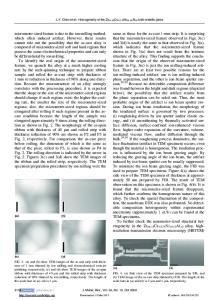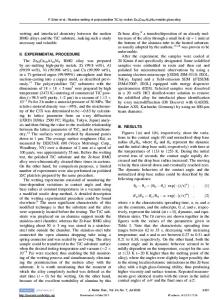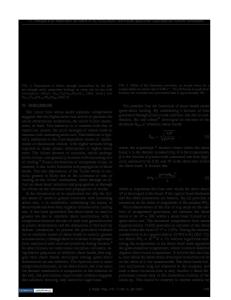Mechanical properties of Zr 57 Nb 5 Al 10 Cu 15.4 Ni 12.6 metallic glass matrix particulate composites
- PDF / 465,087 Bytes
- 6 Pages / 612 x 792 pts (letter) Page_size
- 4 Downloads / 350 Views
Welcome
MATERIALS RESEARCH
Comments
Help
Mechanical properties of Zr57Nb5Al10Cu15.4Ni12.6 metallic glass matrix particulate composites R.D. Conner, H. Choi-Yim, and W.L. Johnson W.M. Keck Laboratory of Engineering Materials, California Institute of Technology, Pasadena, California 91125 (Received 7 May 1998; accepted 3 May 1999)
To increase the toughness of a metallic glass with the nominal composition Zr57Nb5Al10Cu15.4Ni12.6, it was used as the matrix in particulate composites reinforced with W, WC, Ta, and SiC. The composites were tested in compression and tension experiments. Compressive strain to failure increased by more than 300% compared with the unreinforced Zr57Nb5Al10Cu15.4Ni12.6, and energy to break of the tensile samples increased by more than 50%. The increase in toughness came from the particles restricting shear band propagation, promoting the generation of multiple shear bands and additional fracture surface area. There was direct evidence of viscous flow of the metallic glass matrix within the confines of the shear bands.
I. INTRODUCTION
Amorphous alloys were first discovered by Duwez at Caltech in 1960.1 This metallic glass requires a high cooling rate (∼106 K s−1) and can only be produced as thin films. Continued research led to the development of metallic glasses with low (1–103 K s−1) critical cooling rates that can be cast as ingots with large (centimeter) minimum dimensions.2 One of the bulk amorphous alloys developed at Caltech has the nominal composition Zr57Nb5Al10Cu15.4Ni12.6. Zr57Nb5Al10Cu15.4Ni12.6 has mechanical properties similar to other bulk metallic glasses,3,4 such as high strength (∼1.8 GPa), high elastic limit (∼2%), moderate stiffness (85 GPa), and a tendency to fail catastrophically along narrow shear bands. In an effort to increase the toughness of this metallic glass while retaining desirable mechanical properties, Zr57Nb5Al10Cu15.4Ni12.6 was combined with particulate reinforcements to make metallic glass matrix/particulate composites. Ductile metals have been shown to improve the toughness in traditional oxide glasses,5–8 and Zr–Al–Ni–Cu metallic glass reinforced with ZrC showed increases in Young’s modulus, compressive strength, compressive plastic elongation, and hardness.9 The particles interact with the propagating shear band, causing it to slow (or stop) and deflect, thus delaying failure and improving toughness. The properties of Zr57Nb5Al10Cu15.4Ni12.6 and the various ceramic particles and refractory metals used as reinforcement are listed in Table I. This article reports on the measured mechanical properties of Zr57Nb5Al10Cu15.4Ni12.6 metallic glass and Zr57Nb5Al10Cu15.4Ni12.6 matrix particulate composites. The particulate reinforcement increased the toughness 3292
http://journals.cambridge.org
J. Mater. Res., Vol. 14, No. 8, Aug 1999 Downloaded: 23 Feb 2015
of Zr57Nb5Al10Cu15.4Ni12.6 in both tension and compression experiments. Multiple shear banding in composite compression specimens allows a 300% increase in strain to failure compared with monolithic Zr
Data Loading...











